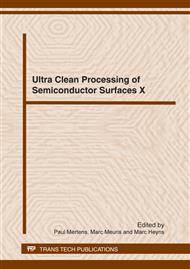p.37
p.41
p.45
p.49
p.53
p.57
p.63
p.67
p.71
Poly-Silicon Wet Removal for Replacement Gate Integration Scheme: Impact of Process Parameters on the Removal Rate
Abstract:
We report in this work some process optimization effort in performing poly silicon removal for replacement gate process integration. Successful wet poly silicon removal after dummy gate patterning is not only conditioned by suitable process conditions during wet removal but is also impacted by process steps prior to gate removal A thorough evaluation of the impact on poly removal from dopants or contaminants introduced in the poly silicon by previous processing is done, resulting in an optimized integration flow with successful poly removal. This work also shows that use of diluted TMAH chemistry instead of diluted ammonia in performing poly silicon removal provides better ability in removing poly silicon especially in narrow gate structures.
Info:
Periodical:
Pages:
53-56
Citation:
Online since:
April 2012
Price:
Сopyright:
© 2012 Trans Tech Publications Ltd. All Rights Reserved
Share:
Citation:


